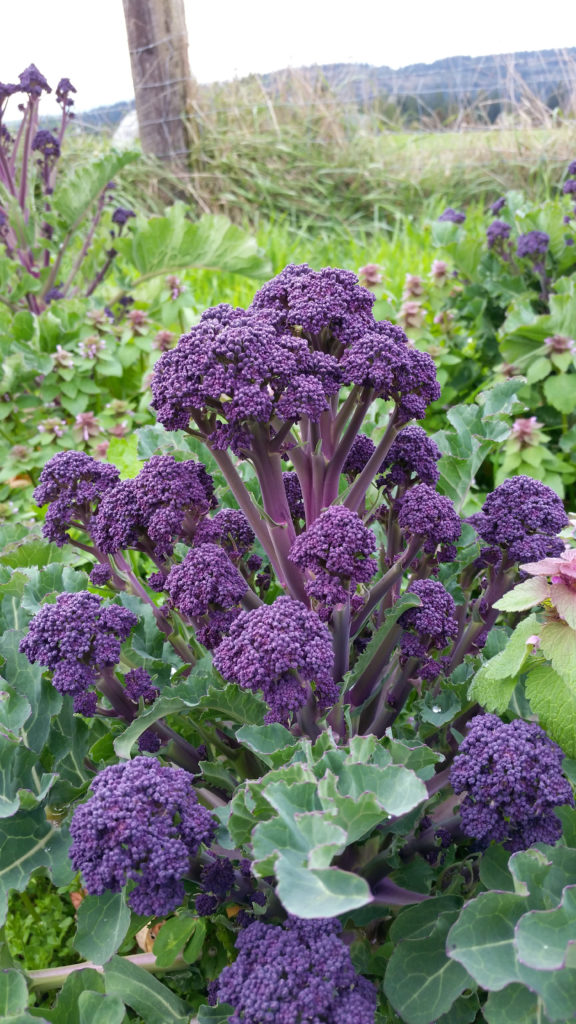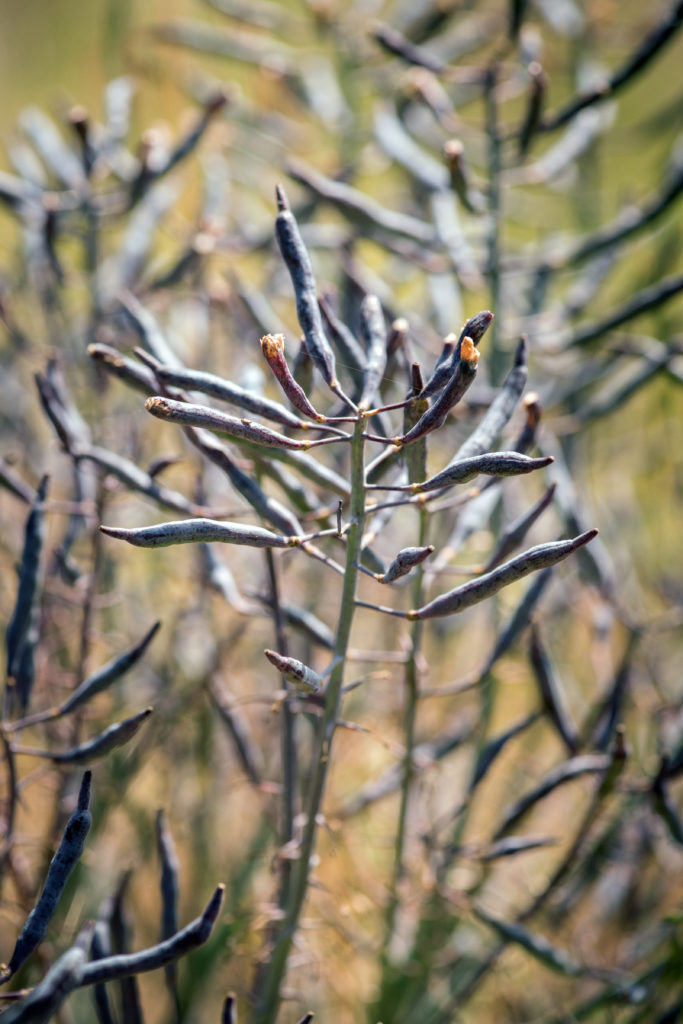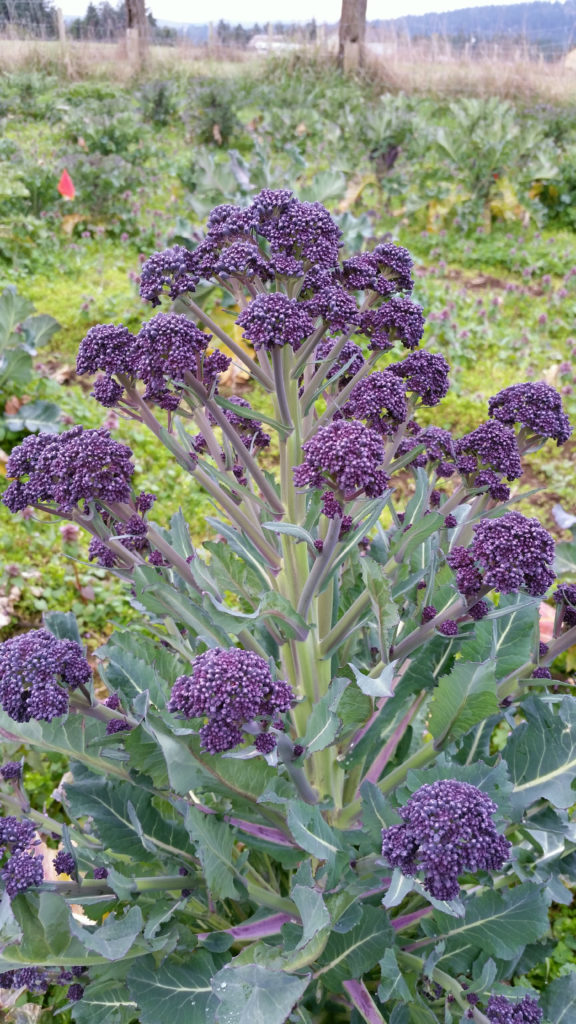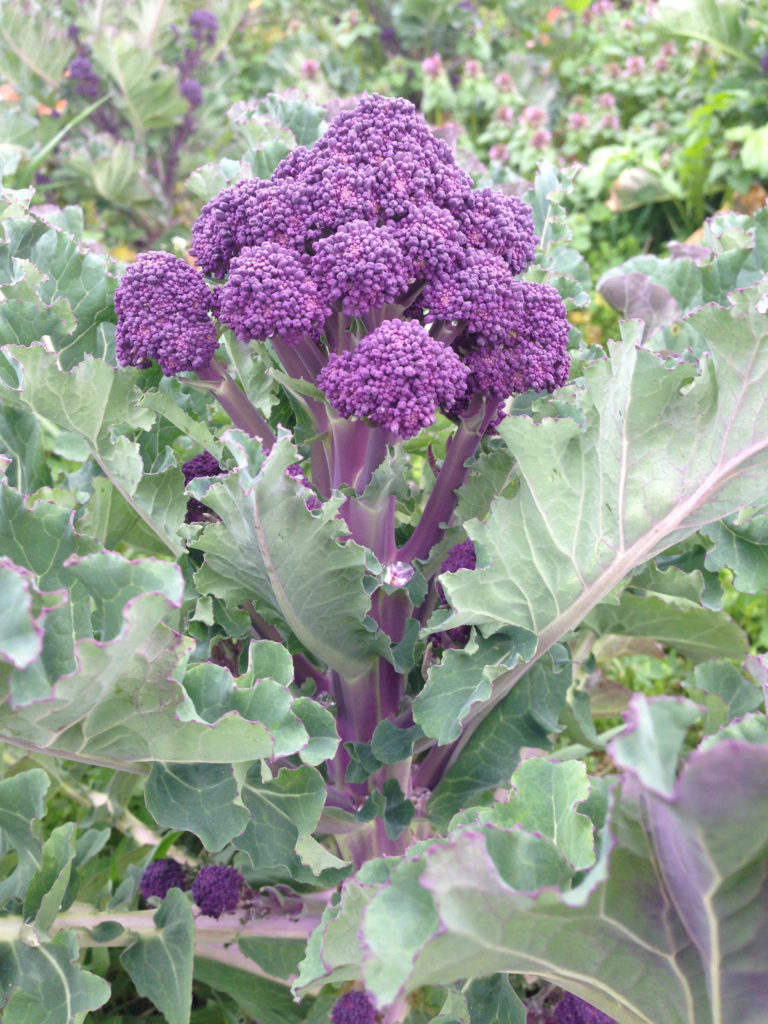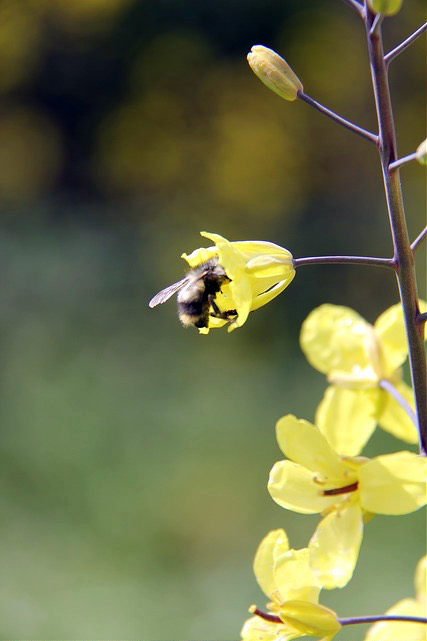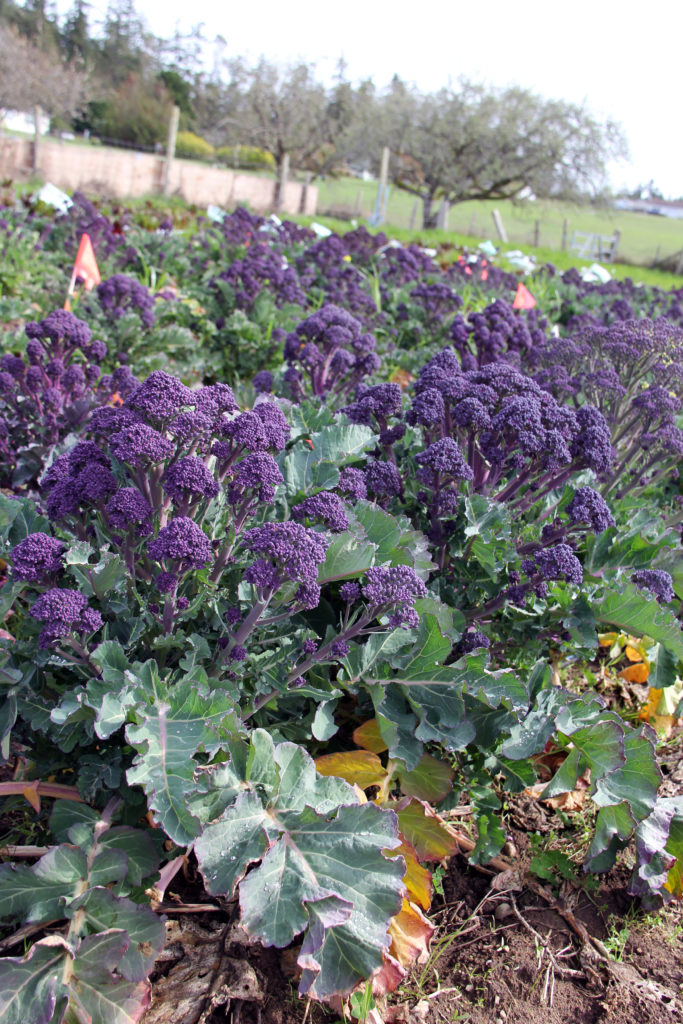Purple Sprouting Broccoli: A Guide to Growing for Fresh Market and Seed in the Pacific Northwest - Organic Seed Alliance
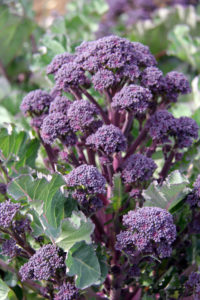
PUBLICATION DATE: NOVEMBER 11, 2021
AUTHORS: LAURIE MCKENZIE AND MICAELA COLLEY, ORGANIC SEED ALLIANCE
FUNDER: This report was made possible through support of the Washington State Department of Agriculture (WSDA) Specialty Crops Block Grant Program as a part of the OSA-led project, Expanding Purple Sprouting Broccoli. AWARD NUMBER: K2306
Table of Contents
- Introduction
- How to Grow Purple Sprouting Broccoli
- Growing Purple Sprouting Broccoli Seed
- Market Opportunities and Challenges
- Conclusion
- References
Introduction
Purple sprouting broccoli (PSB) is a vibrant and nutritious crop that can be overwintered in the maritime climate of the Pacific Northwest (PNW). It is uniquely suited to growing regions with mild winters, like the PNW, where temperatures don’t drop below 15-20°F on average. Planted in late summer and left to overwinter in the field, plants will produce an abundance of tender stems with bright purple sprouts starting in late February and producing through early May. During the winter fully mature leaves can also be harvested and eaten like kale (they are incredibly sweet and taste like broccoli), providing additional fresh nutrition and food throughout the cold months.
The harvest window of late winter and early spring makes PSB standout in the marketplace when little diversity in fresh produce is available and overwintering storage crops are waning. Not only does this timing provide eaters with a new and fresh local food after a winter of storage crops, it provides farmers with income during a time when farm expenses are high with purchasing of the yearly supply of seeds, soil, amendments, and fertility products.
Since PSB is so well suited to the PNW, it presents a unique opportunity for both growers and retailers alike to market and sell the crop regionally and beyond.
Crop History and Nutrition
Purple sprouting broccoli is a member of the Brassicaceae family and distinct for its florets, tender stalks, and ability to grow slowly throughout temperate winters. It is botanically classified as Brassica oleracea var. italica and was once called Asparagus broccoli by the French seed catalog Vilmorin. Purple broccoli is native to the eastern Mediterranean and Central Asian region and was first cultivated in Southern Italy. Seeds for “Sprouting Purple Broccoli” were first listed in the French Vilmorin-Andrieux seed catalog in 1885, which also introduced the colorful cultivar to the United States. Prior to the early 1980s, PSB was little known in marketplaces outside of England and Italy until two English breeders Alan Gray and P. Crisp began working on selecting hardier, more cold tolerant, and better tasting plants. In 1985 Gray and Crisp introduced seeds of an improved cultivar for commercialization (Specialty Produce, 2020).
Purple foods like PSB can be nutritious additions to human diets. The purple color of PSB sprouts is due to an antioxidant compound known as anthocyanin that both serves to protect the plant and offers numerous health benefits to eaters. Scientific studies have shown that anthocyanins have the ability to help protect against cancer, obesity, and diabetes as well as having antioxidative and antimicrobial properties. They also improve visual and neurological health and protect us against various non-communicable diseases (Hock et al, 2017).
Purple sprouting broccoli can be confused with Broccolini which is a hybrid cross of broccoli and gai lan (also known as Chinese broccoli) due to similar appearance and harvest times. Both crops produce at the same time of year and are often sold in floret bunches side by side on produce shelves. However, spring Broccolini is usually grown in California or Arizona, whereas PSB is largely grown in the PNW.
Opportunities for Pacific Northwest Growers
We interviewed five farmers who grow PSB on the Olympic Peninsula and one in the Skagit Valley of Western Washington via an online survey and by phone to inform this publication. Two of these farmers, one on the Olympic Peninsula and one in the Skagit Valley, participated in PSB field trials and shared their experiences with the authors for inclusion in this guide.
Several farmers on the Olympic Peninsula in Washington State reported that PSB production in the late winter and early spring brings a lot of value to their farm operations. The harvest window fills a gap when few other crops are available to be harvested and the greens and sprouts sell well at winter and year-round farmers markets. Crops that can be sold in the off season are high in value and sought after by farmers in the region where (some) year-round production is possible. One farm collaborator shared that the revenue they make at the winter/off-season markets often ends up determining if they will have a net profit from the season or break even.
Another benefit to growers in the PNW is that PSB is also uniquely well suited to produce the seed at market scale. Certified organic PSB seed is extremely limited in the commercial seedscape, with only one variety available as certified organic seed at the time this report was published (November of 2021). The combination of the mild winter climate and increasing market demand and interest, creates an opportunity for more production of PSB for market sales and seed in the region.
This guide provides production and marketing information, and inspiration for growing purple sprouting broccoli greens, sprouts, and seeds in the PNW and comparable climates. Included are general cultivation and marketing tips to support successful production and sales of PSB for growers new to the crop or considering increasing production and expanding sales.
How to Grow Purple Sprouting Broccoli
Vernalization and Overwintering
Growing PSB through the winter is a balancing act for PNW growers. The crop requires a period of cold accumulation known as vernalization to transition from the vegetative, leafy growth stage to the reproductive stage when sprouts form. Growing slowly throughout the winter allows PSB plants to accumulate the cold needed to trigger this transition and provide a bounty of beautiful purple sprouts in the early spring.
However, it can be a challenge to find the right timing to get plants that are the ideal size and stage to survive the winter. Transplanted too early, the plants will grow too large to handle sub-freezing temperatures without sustaining yield reducing damage. Transplanted too late and the plants won’t grow to be large enough to produce robust yields.
The “sweet spot” plant size for winter survival in the PNW is about two-thirds to three-quarters of full maturity size. Both Organic Seed Alliance trials and breeding work and regional growers have found the most reliable success seeding in early- to mid- July and planting out four to six weeks later in mid- to late- August. If the growing area is somewhat protected or in an area of the farm where temperatures are unlikely to dip below 20°F, seeding as early as mid-June and transplanting in mid-July can also be successful. Direct seeding can also be successful for PSB production, however all the growers who participated in this project transplanted their PSB crops.
Purple sprouting broccoli plants can get quite large and like to be given a fair bit of space to grow. They thrive in well fertilized ground. The recommended planting density is 18 inches in row and 24 to 36 inches between rows.
| Production Activity | Recommendation |
|---|---|
| Seeding time | Early to mid July |
| Transplanting time | Mid to late August |
| Between plant spacing | 18 to 24 inches |
| Between row spacing | 24 to 36 inches |
| Lowest temperature tolerated | 20° Fahrenheit |
Succession planting can be a good strategy to find the transplant timing “sweet spot” and ensure success for growers new to PSB production. Spacing out successive seeding and transplanting times by two to three weeks can provide incredibly useful production information and help dial-in the ideal timing for the microclimate of the farm. Two succession plantings should be sufficient to ensure success. Organic Seed Alliance evaluated overwintering potential, yield, and quality of PSB varieties from 2014-2016 with support from the WSDA Specialty Crops Block Grant Program.
As with any overwintering field crop, there is the risk of losing plants and yield involved in producing PSB with the biggest risk factor being temperature. Mitigation strategies to ensure reliable winter survivability include planting PSB: 1) in protected or sheltered areas of the farmscape, such as on the highest and driest ground in the field (this will also help with accessibility for harvesting); 2) between perennial plants such as cane berries; 3) along the sides of greenhouses; or 4) under row cover during the coldest periods of winter. Keep in mind that if row cover is used it should be removed during snow as the weight of the snow on top of the cover can break and damage plants.
Planting Timing and Maturity Types
Purple sprouting broccoli varieties are split into three maturity categories – early, mid, and late – allowing for a production window of about two months. The earliest maturing varieties generally have harvestable sprouts in late February or early March, the mid-maturity varieties come on two to three weeks later, and the latest maturing varieties follow after another two to three weeks. Two harvests are common and reliable for all varieties in all three maturity categories. Additional harvests are possible although the stems and sprouts will steadily decline in size over time, making it less economically viable to continue harvesting for market sales as more and more sprouts will be needed to make a full, marketable bunch. Although varieties are bred to produce sprouts that mature for different harvest timings, they should all be seeded or transplanted at the same time.
It’s important to consider the timing of market opportunities and harvest labor when selecting which varieties and which maturity categories to plant. For instance on the Olympic Peninsula many areas and farms experience hard freezes, snowfall, and freeze-thaw cycles that can be detrimental to PSB production, especially for the early maturing varieties. Also, if growers are not selling at winter or year-round markets, or selling to stores and/or wholesale accounts, early maturing varieties may start producing sprouts before there is a market outlet. For growers in these situations, focusing production on the mid and late maturing varieties is a good strategy.
Harvesting and bunching PSB sprouts can be fairly labor intensive. This presents a balancing act between the need for labor at a time in the year when the field crew is often minimal and the opportunity for a fresh crop to market. This is an important consideration when planning for successful and manageable PSB production and sales.
Managing Sprout Production
There are several strategies for managing and maximizing PSB sprout production. The central sprout is the first production on most varieties, and can be quite large and more similar to a heading broccoli than a sprouting one. Some growers snap and discard this head when it is still small and immature to direct energy for lateral sprout growth. Others allow the central head to develop and either sell it loose by the pound, bundle three or four together (the stems are much thicker and shorter on the central head than the lateral sprouts) and sell them as a bunch, or harvest them for crew eating until there is robust enough production that they can be incorporated into bunches alongside lateral stems. All of these approaches have proven successful, taking into account the timing, market opportunities and demand, and crew and field needs of each farm.
Harvesting Greens
Besides producing a bounty of beautiful and delicious sprouts, PSB leaves can also be harvested during the winter months. Harvests can begin once leaves reach full size. However, harvesting the greens can and will have a yield reducing effect if done too heavily. It will take some experimentation and a bit of trial and error to determine just how heavily greens can be harvested from the plants and still sustain a robust sprout production. One option is to designate plants solely for greens production and harvest, and others for sprout production and harvest.
Growing Purple Sprouting Broccoli Seed
Growing a PSB crop for seed requires a year-long commitment. Seeded and transplanted at the same time as for a greens and/or sprout production, the plants will require an additional three to four months to go through flowering, seed set, and seed maturation. Seed is usually ready for harvest around mid-July and will require a few additional weeks for post harvest handling and cleaning. While this requires a longer commitment of space, time and attention, like other Brassica crops, PSB is a prolific seed producer in the PNW.
Selecting Open-pollinated Varieties
The first step in taking PSB to seed is to determine whether the variety is a hybrid or open-pollinated. Seed saving and seed production of PSB should be done with open-pollinated varieties. Although the commercial seedscape is currently dominated by hybrid varieties, several open-pollinated varieties are currently available.
Hybrid PSB seed production is not feasible for most growers as hybrid seed crops need to be contracted with a seed company who will provide the parent lines and production guidance. It is also not advised to save seed from hybrid varieties of PSB due to a condition called cytoplasmic male sterility (CMS), which can be both naturally occurring and lab induced and results in sterile plants that do not produce pollen. This condition is extremely useful for hybrid seed production but makes seed saving from the resulting hybrids impossible.
Population Size and Isolation Distances
Purple sprouting broccoli is an outcrossing, insect pollinated seed crop. Each plant needs to share and exchange pollen with other plants in order to maintain the health and viability of the variety. It is recommended to grow and save seed from a population of at least 50 plants for high-quality seed. A population is a community of individual plants within a species that can intermate and shares a common gene pool. For more information on population size please see the OSA publication Introduction to On-Farm Organic Plant Breeding.
As with any seed production there is the opportunity to do selection for improvement and adaptation when producing a PSB seed crop. The Introduction to On-Farm Organic Plant Breeding guide is a great resource for learning about the opportunities and techniques for improvement and adaptation of any seed crop. If this is of interest, be sure to seed and plant 20 to 100% more plants (depending on your goals and how genetically diverse the variety is) than you’ll need to end up with to ensure there is a large enough population to make selections from.
Being a Brassica oleracea crop, PSB is cross compatible with any other Brassica oleracea crop such as kale, broccoli, cabbage, collards, and cauliflower. This means that cross-pollination is possible between PSB and any of these other crops. Taking care to ensure there are no other flowering Brassica oleracea crops within close range (up to a mile depending on terrain and natural and structural barriers) is essential to maintaining integrity and variety purity of a PSB seed crop. This can be especially challenging with PSB as it starts to flower right around the same time as raab from other oleracea crops.
General Cultivation Care
Purple Sprouting Broccoli seed development is most sensitive to temperature and moisture during flowering. If temperatures exceed 90°F for extended periods during flowering, pollination and early seed set can be negatively affected. Since flowers are insect pollinated, overhead irrigation or regular precipitation can decrease insect activity and ultimately seed set. Once flowering has finished and early seed development is underway the plants will be more tolerant of hot temperatures and wetting.
Aphids are the biggest pest concern for both PSB sprout and seed production. Aphids can cripple a seed crop by sucking nutrients out of the stems and developing seed pods (siliques). Proactive and early control methods are critical if aphid pressure is high. Phacelia is an excellent companion cover crop for Brassicas that provides habitat, pollen, and nectar for beneficial insects that prey on aphids.
In fields where wind is a problem, staking can be necessary once plants achieve full seed production maturity size. Even without consistently windy conditions, staking may be necessary since the plants can topple under the weight of a heavy top of flowering shoots and developing siliques.
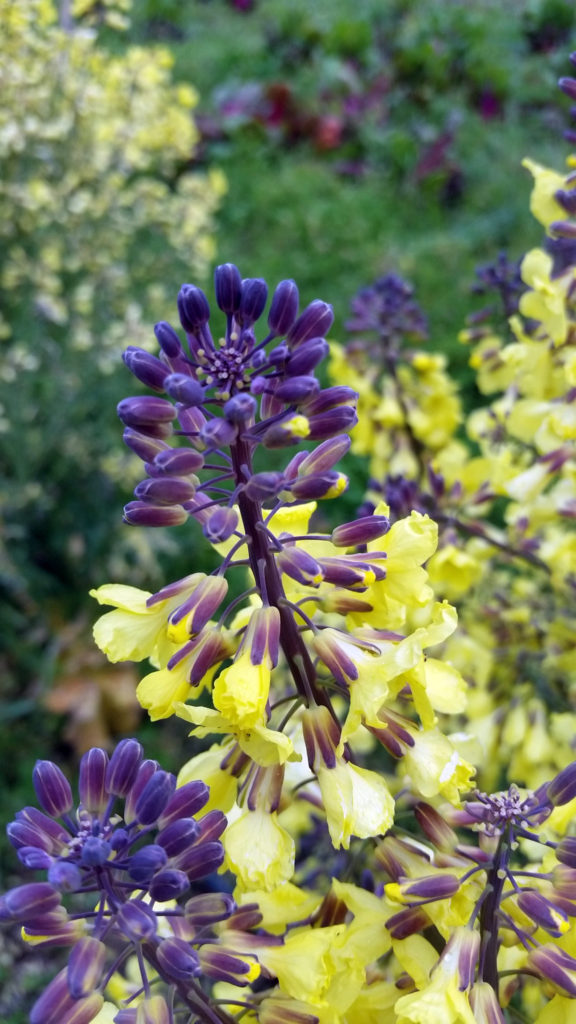
PSB in early flowering. Seed development is most sensitive to temperature and moisture during flowering. 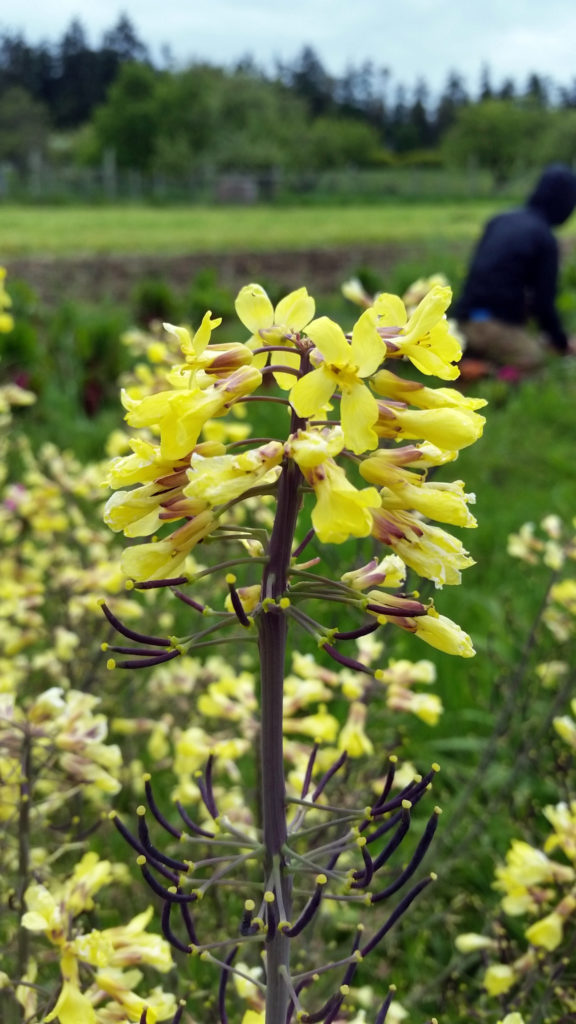
PSB in late flowering with early silique (seed pod) development. 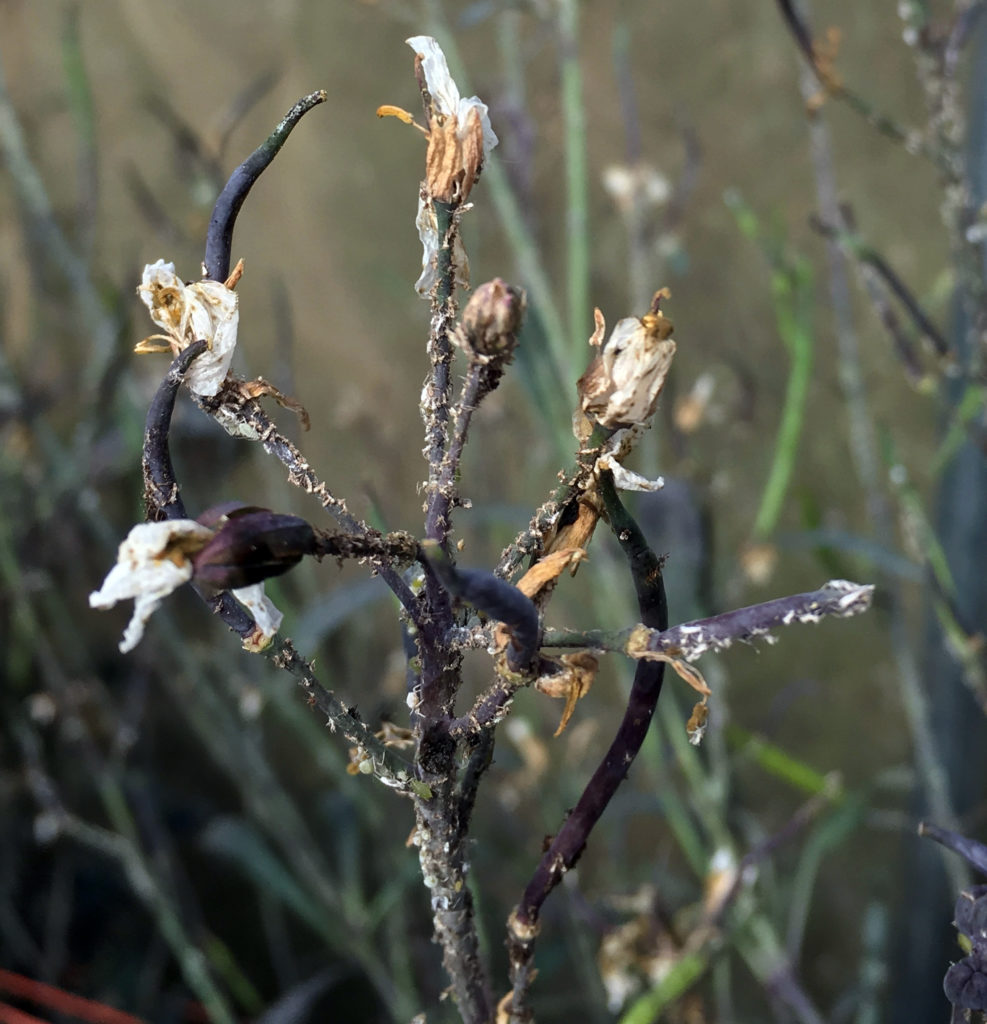
Aphids can cripple a PSB seed crop by sucking nutrients out of the stems and developing seed pods (siliques). 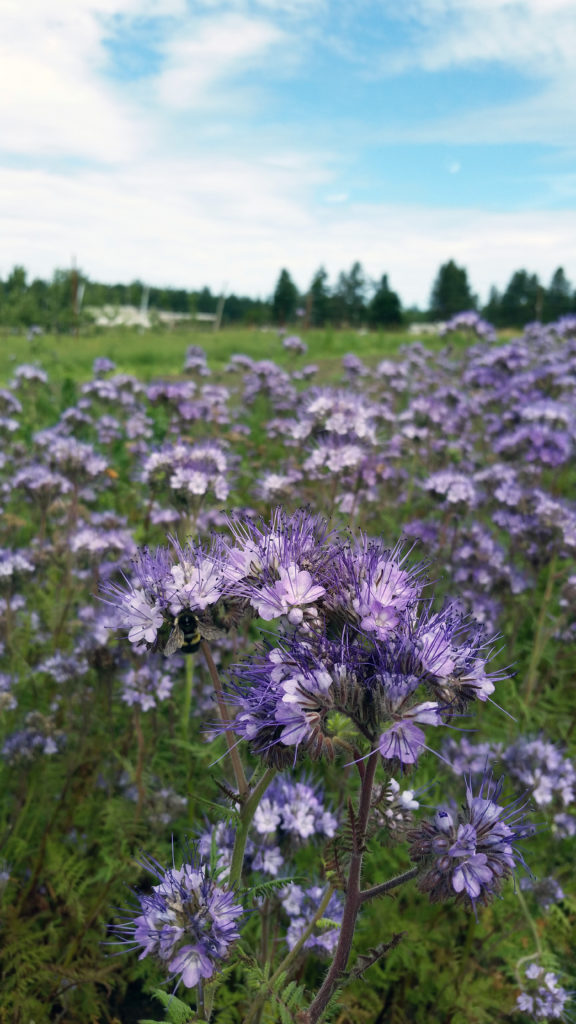
Phacelia provides habitat, pollen, and nectar for beneficial insects that prey on aphids.
Harvest Timing and Techniques
Purple sprouting broccoli will flower over an extended period of time and so seeds will also mature over an extended period of time rather than all at once. There are two indicators for knowing when the seed is ready to harvest. First, when the siliques have turned light tan or buff colored and begin to feel dry or leathery to the touch. Second, when the seeds inside have turned from green to brown/black/purple.
Depending on the size of the production it is generally easiest to cut whole plants when approximately 60 to 70% of the siliques are mature, and lay them out on landscape fabric to dry down and complete maturity. This allows any immature seeds to continue maturing using the nutrients and energy remaining in the stem of the plant. For smaller productions, multiple harvests of the branches with the most mature siliques can be a viable technique. When seeds are mature and adequately dry, the silques will break open easily to release the seed. Be sure to harvest before this shattering which results in seed loss during harvesting.
See OSA’s resource library for additional resources on seed cleaning.
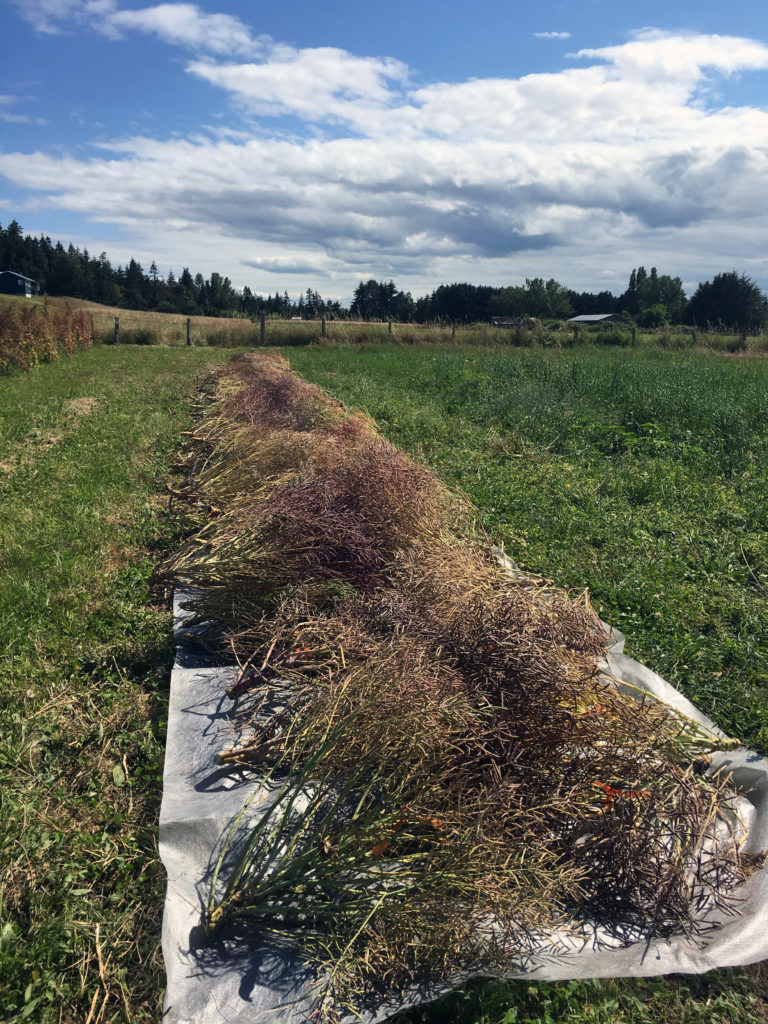
Whole PSB plants cut and laid on geotextile fabric for final seed maturation and dry down.
Market Opportunities and Challenges
Growers in northwestern Washington State share that PSB is an excellent overwintering crop with increasing market demand, interest, and potential. Growers report that the potential for income and diversifying crops in the late winter outweighs the risks of crop losses in years with severe weather or pests. Several farmers report that they have not yet maxed out the market opportunities for selling both PSB sprouts and greens.
Direct sales at farmers markets, farm stands, and community supported agriculture (CSA) programs were the most successful and economically viable markets of the growers we interviewed. Winter and off-season markets were noted to be especially successful outlets for PSB sales as consumers were looking for and excited by the fresh and visually beautiful crop. Wholesale opportunities were noted as an option by most growers, but mainly as a backup to direct sales as wholesale marketing usually is not as lucrative as direct sales.
One of the main bottleneck points for farmers expanding PSB production is labor. As an overwintered crop, growers are challenged by not having a large enough field crew or staff to harvest PSB during the winter months when other work on the farm is minimal.
Harvesting PSB greens is an uncommon practice with untapped market potential. Only one grower reported harvesting the greens for winter sales and markets. Selling the bunched leaves as ‘Leaf Broccoli’ and explaining to consumers to prepare and cook it just like kale but that it will taste like broccoli was both successful and popular. It was so successful that it generated three to four times the income than was made off of selling bunches of sprouts. Harvesting and marketing the leaves also provided financial security if the plants sustained any sprout yield-reducing damage from freezing temperatures or freeze-thaw cycles. Money had already been made, thus mitigating the risk of late production loss.
Even though PSB is a specialty crop, farmers reported that most consumers are familiar with it and look forward to its arrival at the market. Little to no extra time or education was needed to encourage consumers to buy PSB or tell them how to prepare and eat it. The pop of bright color makes it a standout on the shelf and is an eye-catching draw for consumers. After a winter of storage crops and hardy greens, PSB offers a welcome, delicious, and nutritious fresh food.
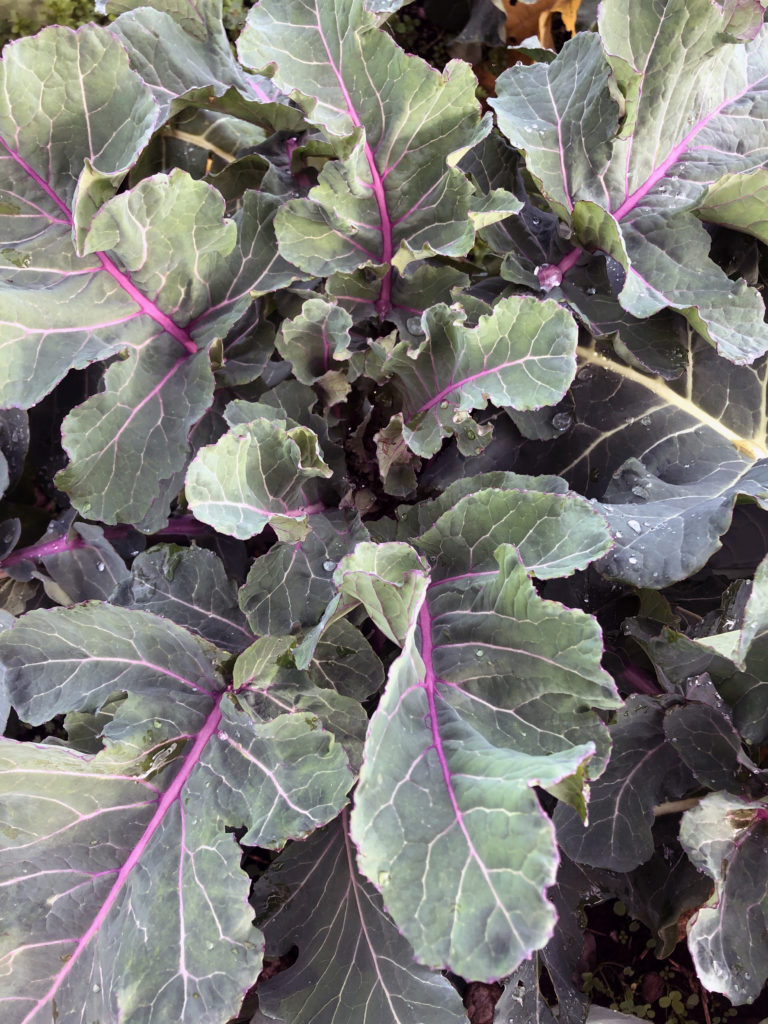
PSB leaves offer an untapped market potential in the PNW. 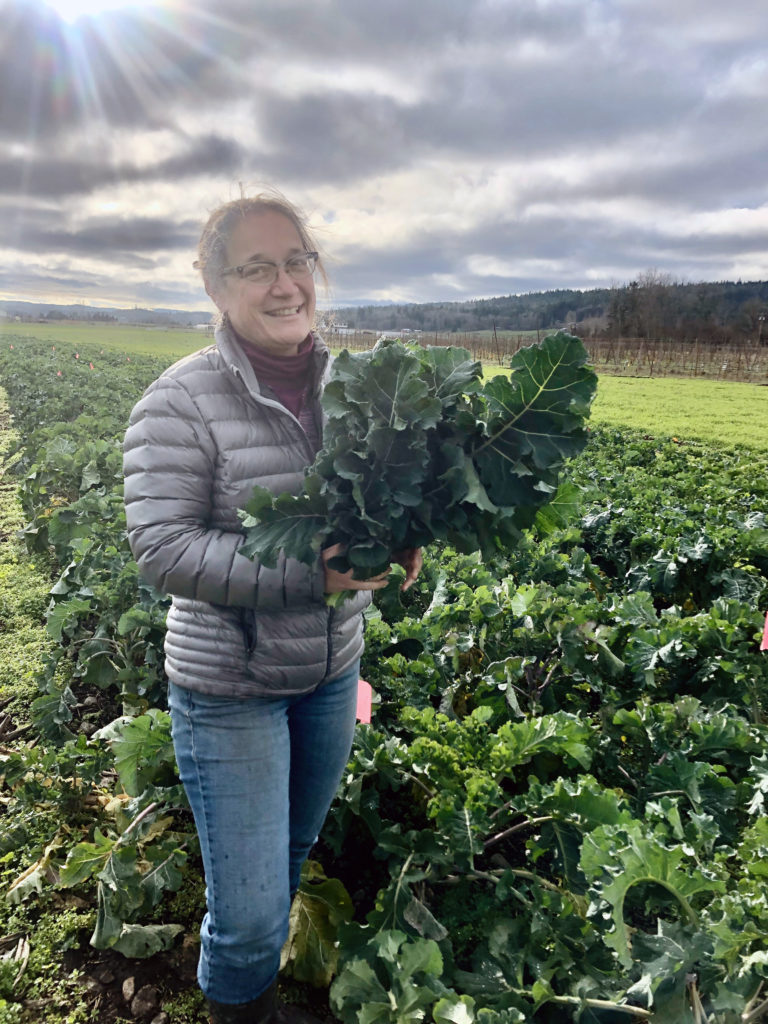
OSA board member Amy Grondin holding PSB greens.
Conclusion
Purple sprouting broccoli is a crop ripe with potential and expansive opportunity. It’s relatively easy to produce in the PNW, has increasing market recognition and demand, and many possibilities for increasing production and sales within the region and beyond. Purple sprouting broccoli offers a fresh and vibrant winter delicacy at a time of year when options are low and can double its value in seed production.
Keys to success in producing a robust PSB crop are to find the “sweet spot” time to transplant and determining which varieties will work best for your farm microclimate and market opportunities. Try something new and harvest PSB greens for year-round and winter markets. Purple sprouting broccoli is an excellent overwintering crop for farmers and growers in the PNW. It’s a delicious and beautiful crop that can add health and enjoyment to farm or garden.
References
Hock, Eng Khoo; Azrina, Azlan; Sou, Teng Tang; See, Meng Lim. (2017) Anthocyanidins and athocyanins: colored pigments as food, pharmaceutical ingredients, and the potential health benefits. Food and Nutrition Research. 61(1): 1361779. Published online 2017 Aug 13. doi: 10.1080/16546628.2017.1361779 (Accessed 11.5.2021)
Specialty Produce. (2020) Purple Broccoli. Available at: https://specialtyproduce.com/produce/Purple_Broccoli_4084.php (Accessed 11, 05, 2021).

